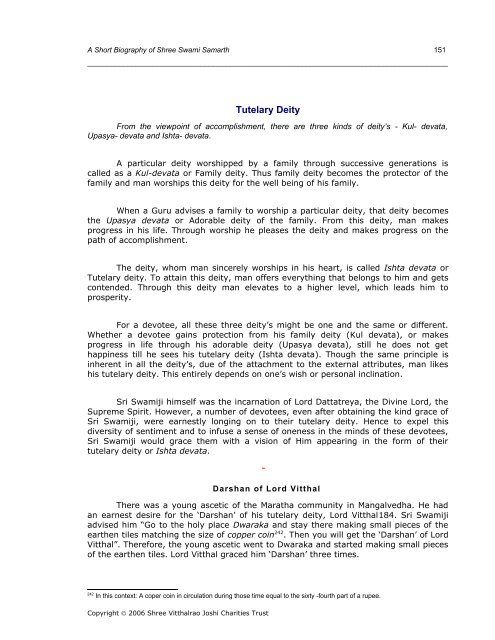Shree Swami Samarth Maharaj
Shree Swami Samarth Maharaj
Shree Swami Samarth Maharaj
Create successful ePaper yourself
Turn your PDF publications into a flip-book with our unique Google optimized e-Paper software.
A Short Biography of <strong>Shree</strong> <strong>Swami</strong> <strong>Samarth</strong> 151<br />
_________________________________________________________________________________________<br />
Tutelary Deity<br />
From the viewpoint of accomplishment, there are three kinds of deity’s - Kul- devata,<br />
Upasya- devata and Ishta- devata.<br />
A particular deity worshipped by a family through successive generations is<br />
called as a Kul-devata or Family deity. Thus family deity becomes the protector of the<br />
family and man worships this deity for the well being of his family.<br />
When a Guru advises a family to worship a particular deity, that deity becomes<br />
the Upasya devata or Adorable deity of the family. From this deity, man makes<br />
progress in his life. Through worship he pleases the deity and makes progress on the<br />
path of accomplishment.<br />
The deity, whom man sincerely worships in his heart, is called Ishta devata or<br />
Tutelary deity. To attain this deity, man offers everything that belongs to him and gets<br />
contended. Through this deity man elevates to a higher level, which leads him to<br />
prosperity.<br />
For a devotee, all these three deity’s might be one and the same or different.<br />
Whether a devotee gains protection from his family deity (Kul devata), or makes<br />
progress in life through his adorable deity (Upasya devata), still he does not get<br />
happiness till he sees his tutelary deity (Ishta devata). Though the same principle is<br />
inherent in all the deity’s, due of the attachment to the external attributes, man likes<br />
his tutelary deity. This entirely depends on one’s wish or personal inclination.<br />
Sri <strong>Swami</strong>ji himself was the incarnation of Lord Dattatreya, the Divine Lord, the<br />
Supreme Spirit. However, a number of devotees, even after obtaining the kind grace of<br />
Sri <strong>Swami</strong>ji, were earnestly longing on to their tutelary deity. Hence to expel this<br />
diversity of sentiment and to infuse a sense of oneness in the minds of these devotees,<br />
Sri <strong>Swami</strong>ji would grace them with a vision of Him appearing in the form of their<br />
tutelary deity or Ishta devata.<br />
Darshan of Lord Vitthal<br />
There was a young ascetic of the Maratha community in Mangalvedha. He had<br />
an earnest desire for the ‘Darshan’ of his tutelary deity, Lord Vitthal184. Sri <strong>Swami</strong>ji<br />
advised him “Go to the holy place Dwaraka and stay there making small pieces of the<br />
earthen tiles matching the size of copper coin 242 . Then you will get the ‘Darshan’ of Lord<br />
Vitthal”. Therefore, the young ascetic went to Dwaraka and started making small pieces<br />
of the earthen tiles. Lord Vitthal graced him ‘Darshan’ three times.<br />
242 In this context: A coper coin in circulation during those time equal to the sixty -fourth part of a rupee.<br />
Copyright © 2006 <strong>Shree</strong> Vitthalrao Joshi Charities Trust


